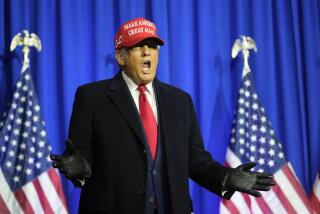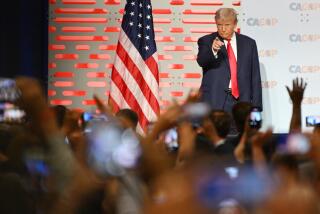First immigration, then guns, now tariffs: Policy chaos defines Trump’s White House

President Trump’s daily public schedule had been emailed later than usual the evening before, near 11 p.m., yet by Thursday morning it had already been upended. The update arrived before breakfast, straight from the president’s Twitter account to his millions of followers.
“Looking forward to 3:30 P.M. meeting today at the White House,” Trump wrote — to impose the tariffs on steel and aluminum imports that most Republicans, his top advisors, many foreign allies and numerous American companies had implored him to reconsider. Aides scrambled to add the event — forced not for the first time, or even the first time this month, to react to the policy chaos the president increasingly seems to revel in.
Later, in rambling remarks to reporters before a morning Cabinet meeting, the president touched on no less than 15 different issues that he said he is working on. “A lot of great things are being done,” Trump said. “A lot of things are happening right now, as we speak.”
Many things are not getting done, however, and largely because of the president’s penchant for changing his mind, thinking aloud and then moving on to something else. Every White House juggles a multitude of issues and problems. What sets Trump’s White House apart is how much seems to happen on the fly, driven by a president who calls the shots with proud disregard for policy ramifications and process.
The result is confusion. “Each day is a new episode in the reality TV show,” said historian Allan Lichtman, a professor at American University. “It’s frightening how quickly he turns to the next thing.”
Trump’s tumultuous first year as president was salvaged when the Republican-controlled Congress sent him a massive tax cuts bill to sign in December. That had Republican allies hoping for a more disciplined, productive alliance for the year ahead.
It hasn’t been so.
The tariffs debate of March began with the president’s unexpected announcement last week of imminent levies on steel and aluminum — a statement that took even most advisors by surprise, and provoked Trump’s chief economic advisor, Gary Cohn, to announce his resignation this week.
Set aside was the previous debate over the president’s vacillations on policies addressing gun violence and school safety, the topic that consumed much of February after the massacre of 14 students and three educators at a Parkland, Fla., high school. And that debate followed the still-unresolved fight that began the year — over Trump’s push to replace the Obama-era program protecting from deportation hundreds of thousands of young immigrants, the so-called Dreamers, who were brought to the country illegally as children.
All but forgotten has been a fourth issue that Trump had called a top priority for 2018: an infrastructure plan to spur the economy by fixing the nation’s crumbling roads, bridges, waterways, airports, sewers, levees and more. He has said little about it, and unenthusiastic Republican leaders in Congress suggest they will not act on the matter this year.
Aside from the tariffs, which Trump had authority to impose without Congress, each of those issues he has called priorities now languishes. Lawmakers express confusion over just what he wants to do, and he turns his attention elsewhere. Although the president said at the Cabinet meeting that bills to strengthen background checks for some gun purchasers “are moving along in Congress,” in fact the House and Senate have made little progress.
On Thursday, Trump returned briefly to the subject of how to respond to mass shootings like the killings in Parkland, by hosting a closed-door roundtable on violent video games and whether those are a factor in motivating mass shooters. Critics complained that, by turning his attention to video games, Trump was distracting from proposals to limit guns like the AR-15 assault rifle used in the Florida massacre and past shootings.
A day earlier, the president likewise was back on the subject of immigration and Dreamers, briefly, but only to blame Democrats for the legislative impasse in a speech to a conservative Latino business group.
Long before his political career, Trump disclosed his love of chaos in his 1987 book, “The Art of the Deal.”
“I keep a lot of balls in the air,” he wrote, “because most deals fall out.”
His friends defend the president, and point to the legal troubles that vex him. Eric Bolling, a friend who talks to Trump regularly, said it is hard to move forward when dealing with the “constant overhang” of a special counsel’s inquiry, which is investigating the Trump campaign’s possible coordination with Russia’s interference in the 2016 election.
“Lawyers chew up so much of your valuable time, especially when they’re talking to every person,” Bolling said. “I’m surprised he has gotten this much accomplished.”
Lately, Trump has also been dogged by allegations from an adult-film star, Stormy Daniels, who says she had an affair with Trump. She was paid $130,000 by Trump’s lawyer to remain silent before the 2016 election. She reportedly is preparing to speak publicly about the matter soon.
Also exacerbating Trump’s ability to make and push policies that advance his agenda, or respond to unexpected crises, is the unusually high turnover in his White House and the administration more broadly, and the vacancies that remain in many essential offices, including ambassadorships.
Trump often has refused to appoint people who spoke out against him during the campaign, leaving a large pool of experienced Republicans and policy experts on the sidelines. Now, more than a year into his presidency, the perceived dysfunction and Trump’s record of publicly humiliating top advisors has made some potential recruits unwilling to enter his administration.
Trump nonetheless lauded his practice of pitting advisors against each other at an appearance this week alongside Sweden’s prime minister.
“I like conflict. I like having two people with different points of view, and I certainly have that,” he said. “And then I make a decision. But I like watching it, I like seeing it, and I think it’s the best way to go.”
Even some critics say Trump could be knocking items off his to-do list if he would just focus and show discipline. The tariff plan is a prime example, said Senate Democratic leader Charles E. Schumer of New York.
“The president’s proposal does more harm to Europe and other allies like Canada than it does to China,” Schumer said. “That’s what’s wrong with it. It’s so typical of this White House. Even when they have a good idea, they mess it up because they don’t think it through.
“The haphazard way these tariffs were put together has caused policy to miss the mark,” said Schumer.
Lichtman, the history professor, suggested that the apparent haphazardness is actually part of Trump’s plan.
“The one thing Trump is good at is distraction and deflection,” he said. “He’ll talk about difficult things, but then he’ll move on to something else and the conversation will turn to that.
“Whatever happened to his pledge that ‘I’m going to challenge the NRA’?” Lichtman said, referring to Trump’s recent comments about the National Rifle Assn.
“He moved on,” blaming school shootings on mental health issues and violent video games, he said. “That’s why absolutely nothing is going to come from this school shooting.”
Bolling disagreed. A former Fox News host, he became friends with Trump after Bolling’s adult son died of an opioid overdose last year. The president called him to offer condolences, and continues to call on a regular basis to check in and talk things over.
“He’s been amazingly empathetic and compassionate,” Bolling said. “I know he cares about the issue. And I know he will try his best to get something done.”
Times staff writer Cathleen Decker contributed to this report.
Twitter: @cparsons
More to Read
Get the L.A. Times Politics newsletter
Deeply reported insights into legislation, politics and policy from Sacramento, Washington and beyond. In your inbox three times per week.
You may occasionally receive promotional content from the Los Angeles Times.







